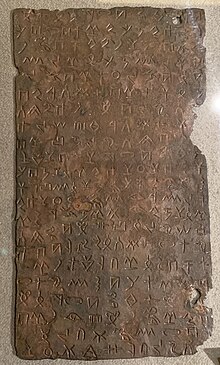This article needs additional citations for verification. (February 2020) |
| Byblos script | |
|---|---|
 | |
| Script type | Undeciphered
(probably a syllabary or abugida) |
Time period | Estimated between 1800 BC and 1400 BC |
| Languages | Unknown |
| Related scripts | |
Parent systems | |
The Byblos script, also known as the Byblos syllabary, Pseudo-hieroglyphic script, Proto-Byblian, Proto-Byblic, or Byblic, is an undeciphered writing system, known from ten inscriptions found in Byblos, a coastal city in Lebanon. The inscriptions are engraved on bronze plates and spatulas, and carved in stone. They were excavated by Maurice Dunand, from 1928 to 1932, and published in 1945 in his monograph Byblia Grammata. The inscriptions are conventionally dated to the second millennium BC, probably between the 18th and 15th centuries BC.
Examples of the script have also been discovered in Egypt, Italy, and Megiddo (Garbini, Colless).